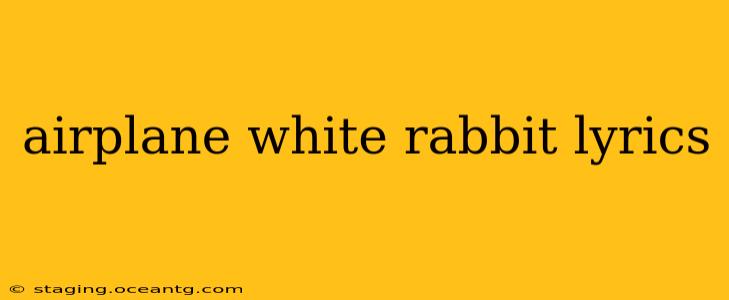Jefferson Airplane's "White Rabbit" isn't just a song; it's a psychedelic journey, a cryptic allegory, and a timeless classic. Its enigmatic lyrics have captivated listeners for decades, sparking endless interpretations and fueling its enduring popularity. This deep dive explores the song's lyrics, unraveling their meaning and examining the cultural context that birthed this iconic piece of counter-culture history.
Understanding the Narrative:
The song's narrative unfolds like a dream, weaving together imagery from Lewis Carroll's Alice's Adventures in Wonderland and the burgeoning drug culture of the 1960s. Grace Slick's ethereal vocals paint a picture of a journey into altered states of consciousness, subtly hinting at the experiences of drug use without explicitly mentioning them. The rabbit, a recurring symbol in Carroll's work, becomes a guide to a world beyond the ordinary.
Deciphering the Lyrics: A Line-by-Line Exploration
One of the most fascinating aspects of "White Rabbit" is the ambiguity of its lyrics. Each line can be interpreted in multiple ways, depending on the listener's perspective and familiarity with the source material. Let's explore some key phrases:
-
"One pill makes you larger, and one pill makes you small": This directly references Alice's experiences with eating and drinking various substances that alter her size. In the context of the 1960s, this is a potent metaphor for the effects of psychedelic drugs.
-
"And the ones that mother gives you don't do anything at all": This line contrasts the potentially transformative effects of illicit drugs with the perceived ineffectiveness of conventional societal norms or medications.
-
"Go ask Alice, I think she'll know": This is a clear nod to Alice, inviting the listener to delve deeper into the world of altered perception and questioning established realities.
-
"When the men on the chessboard get up and tell you where to go": This line adds a layer of social commentary, hinting at the manipulation and control exerted by powerful institutions.
Frequently Asked Questions (FAQ)
Here, we address some common questions surrounding the lyrics and their meaning:
H2: What drugs is "White Rabbit" about?
While the song never explicitly names specific substances, the imagery strongly suggests the use of psychedelic drugs like LSD. The references to altered perceptions, size changes, and a journey into a surreal world are common descriptions of psychedelic experiences.
H2: Is "White Rabbit" a pro-drug song?
The song's interpretation is subjective. While it depicts the effects of altered states of consciousness, it doesn't explicitly endorse or condemn drug use. It's more accurately described as an exploration of the experiences and potential consequences of such journeys. The ambiguous nature of the lyrics allows for multiple interpretations.
H2: What is the significance of the white rabbit?
The white rabbit serves as a guide, a symbol of the unknown, and a portal to a different reality. It acts as a catalyst for Alice's (and by extension, the listener's) journey into the psychedelic realm. Its prominent role connects the song directly to the imagery and themes of Alice's Adventures in Wonderland.
H2: What is the meaning of the line "Feed your head"?
This phrase encourages intellectual and spiritual exploration. It suggests that expanding one's consciousness through experience, questioning authority, and embracing new ideas is crucial.
The Legacy of "White Rabbit":
"White Rabbit" remains a powerful testament to the counter-culture movement of the 1960s and its exploration of consciousness expansion. Its enduring popularity is a result of its evocative lyrics, its captivating melody, and its ability to resonate with listeners on multiple levels. The song's ambiguous nature allows for individual interpretation, ensuring its continued relevance and fascination for generations to come. It stands as a reminder of the power of art to reflect, question, and inspire.
